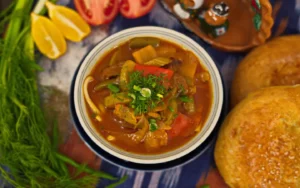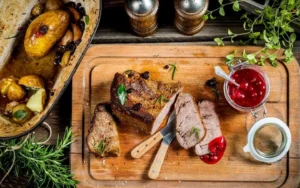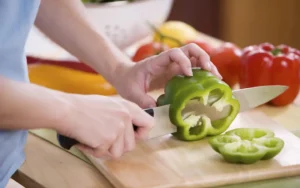Cooking is an art that requires skill, knowledge, and experience. Whether a professional chef or a home cook, mastering different cooking techniques can take dishes to the next level. This article explores the “Cooking Way of the Pros” and shares some techniques professional chefs use to create delicious meals.
From sous vide to sautéing, we’ll cover a range of cooking methods that can help you achieve professional-level results. Whether cooking for friends and family or running a restaurant kitchen, these techniques can help you take your cooking to the next level. So, let’s dive in and discover the professionals’ secrets!
Sauté Your Way to Success: Mastering the Art of Sautéing
Sautéing is a culinary method where food is cooked rapidly in a small quantity of oil or fat at high temperatures. It’s a versatile method that can be used to prepare various ingredients, from vegetables to meats and seafood. If you want to take your cooking skills to the next level, mastering the art of sautéing is a must.
To sauté like a pro, start by selecting the right pan. A skillet or sauté pan with a flat bottom and straight sides is ideal. Next, choose an oil like canola or vegetable oil with a high smoke point, and heat it over medium-high heat. Once the oil is hot, stir your ingredients frequently to prevent sticking.
Add flavor to your sautéed dishes, plus aromatics like onions, garlic, and ginger. Season your food with salt and pepper to taste.
With practice, you can master the art of sautéing and use it to prepare a wide range of delicious and healthy meals. So, sauté your way to success and elevate your cooking skills to the next level.
Read more about kitchen cabinet types
Roasting: Techniques for Juicy, Flavorful Dishes
Roasting is a cooking method that lets the food cook at high heat in an oven or over an open flame. It’s a popular technique for preparing meats and vegetables, and it’s known for producing juicy, flavorful dishes. If you want to learn how to roast like a pro, keep a few key techniques in mind.
First, start with the right cut of meat or type of vegetable. Choose a cut with plenty of marbling, such as a ribeye or pork shoulder for meats. Select firm, hearty varieties like carrots, potatoes, and squash for vegetables.

Next, season your food generously with salt, pepper, and other herbs or spices. Add aromatics like garlic, onion, or rosemary to infuse your dish with even more flavor.
When roasting, it’s important to use high heat to ensure that the outside of your food cooks quickly and develops a crispy, caramelized crust. You can also use a roasting rack to elevate your food and allow air to circulate it.
With practice, you can master the art of roasting and use it to create a wide range of delicious and impressive dishes. So, try different cuts of meat and vegetables, experiment with seasonings, and discover your roasting style.
Braising: Slow-Cooking for Tender, Flavorful Meat
Braising is a cooking technique involving browning meat and then cooking it slowly in liquid until it becomes tender and flavorful. It’s a great method for tougher cuts of meat, such as beef brisket or lamb shanks, and it can also be used for vegetables.
To braise like a pro:
- Stir your meat in a hot pan to develop a rich, caramelized crust.
- Add aromatic vegetables like onions, carrots, and celery, and cook them until tender.
- Add liquid like broth or wine, and bring it to a simmer.
- Cover the pan with a lid, and move it to a preheated oven to cook slowly until the meat gets tender and falls off the bone.

Braising is a versatile technique that can be used to prepare various dishes, from stews and pot roasts to braised short ribs and pork belly. You can also experiment with flavorings, like herbs and spices, to create a flavorful dish.
With practice, you can master the art of braising and use it to create tender, flavorful meat dishes that will impress your family and friends. So, try different cuts of meat and vegetables, experiment with seasonings, and discover your braising style.
Explore more fireless cooking
Knife Skills: The Foundation of Professional-Quality Cooking
Knife skills are an essential foundation for professional-quality cooking. Whether you’re a home cook or a professional chef, knowing how to handle a knife properly makes a difference when preparing ingredients quickly and safely.
To start honing your knife skills, choosing the right knife for the job is important. A chef’s knife is a versatile tool that can be used for a wide range of cutting tasks, from slicing and chopping to dicing and mincing. Other knives, like paring and serrated knives, are better suited for tasks like peeling and cutting bread.
Once you have the right knife, learning proper cutting techniques is important, including holding the knife properly, rocking to chop ingredients, and keeping your fingers out of harm’s way.

In addition to technique, it’s also important to keep your knives sharp. Sharp knives are less dangerous than dull knives because dull knives require more force, which can lead to slips and cuts. Knives can get sharpened with a sharpening stone or a knife sharpener.
Improving your knife skills can save time in the kitchen, create more uniform cuts of ingredients, and reduce the risk of injury. So, practice often, take your time, and develop your style of knife work.
Learn more about kitchen design
conclusion
In conclusion, “Cooking Way of the Pros: Techniques for Professional-Quality Meals” is an invaluable resource for anyone improving their cooking skills and creating restaurant-quality dishes. With its comprehensive coverage of various cooking techniques and skills, the guide provides a wealth of practical tips, step-by-step instructions, and useful insights to help elevate your cooking abilities and produce amazing meals.
The guide emphasizes the importance of mastering essential skills like knife work, plating, and seasoning, which are key to achieving professional-quality results. By paying attention to these details and honing your skills, you can create dishes that taste amazing and look beautiful.
In addition, the guide covers a range of cooking techniques, each with its benefits, challenges, and nuances. By understanding the differences between techniques like sautéing, roasting, braising, and grilling, you can choose the best method for each recipe and produce impressive dishes.
Furthermore, the guide encourages experimentation and creativity while emphasizing the importance of attention to detail. You can create your dishes and stand out by incorporating your unique style and flavor preferences.
Overall, “Cooking Way of the Pros: Techniques for Professional-Quality Meals” is an essential guide for anyone passionate about cooking and wanting to take their skills to the next level. By following the tips and techniques outlined in the guide, you can become a master of the cooking way and produce dishes that are not only delicious but also visually stunning. So, what are you waiting for? Start exploring the world of professional cooking today!
KEYWORDS:
